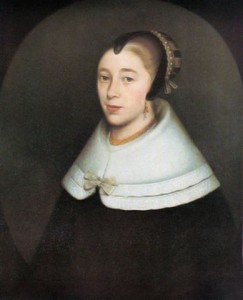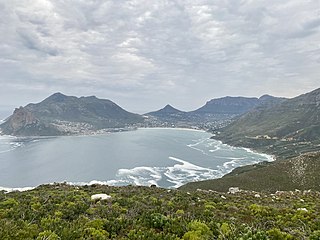Related Research Articles

Robben Island is an island in Table Bay, 6.9 kilometres (4.3 mi) west of the coast of Bloubergstrand, north of Cape Town, South Africa. It takes its name from the Dutch word for seals (robben), hence the Dutch/Afrikaans name Robbeneiland, which translates to Seal(s) Island.

Table Bay is a natural bay on the Atlantic Ocean overlooked by Cape Town and is at the northern end of the Cape Peninsula, which stretches south to the Cape of Good Hope. It was named because it is dominated by the flat-topped Table Mountain.

Johan Anthoniszoon "Jan" van Riebeeck was a Dutch navigator and colonial administrator of the Dutch East India Company.

Maria van Riebeeck was a French Huguenot who was the first wife of Jan van Riebeeck, the Dutch colonial administrator and first commander of the settlement at the Cape.

Griqualand West is an area of central South Africa with an area of 40,000 km2 that now forms part of the Northern Cape Province. It was inhabited by the Griqua people – a semi-nomadic, Afrikaans-speaking nation of mixed-race origin, who established several states outside the expanding frontier of the Cape Colony. It was also ancestral home to the Tswana and Khoisan peoples.

Cape Malays also known as Cape Muslims or Malays, are a Muslim community or ethnic group in South Africa. They are the descendants of enslaved and free Muslims from different parts of the world, specifically Indonesia and other Asian countries, who lived at the Cape during Dutch and British rule.
Jan van Riebeeck landed at the Cape on 6 April 1652, setting up a supply station and fortifications for the Dutch East India Company. The decade saw the beginning of European settlement, marked by the introduction of crops from Europe and the New World and culminating in war with the Khoikhoi in 1659.

Kuils River is a town in the Western Cape, South Africa, 25 km east of Cape Town CBD at the gateway of the Cape Winelands. It is also the name of the main tributary of the Eerste River, and forms part of the Eastern Suburbs of the City of Cape Town.

Hout Bay is a seaside suburb of Cape Town in the Western Cape province of South Africa. It is situated in a valley on the Atlantic seaboard of the Cape Peninsula, twenty kilometres south of the Central business district of Cape Town. The name "Hout Bay" can refer to the town, the bay on which it is situated, or the entire valley.

The Castle of Good Hope is a bastion fort built in the 17th century in Cape Town, South Africa. Originally located on the coastline of Table Bay, following land reclamation the fort is now located inland. In 1936 the Castle was declared a historical monument and following restorations in the 1980s it is considered the best preserved example of a Dutch East India Company fort.
The area known today as Cape Town has no written history before it was first mentioned by Portuguese explorer Bartholomeu Dias in 1488. The German anthropologist Theophilus Hahn recorded that the original name of the area was '||Hui !Gais' – a toponym in the indigenous Khoi language meaning "where clouds gather."

The "!Oroǀõas" ("Ward-girl"), spelled in Dutch as Krotoa or Kroket, otherwise known by her Christian name Eva, was a !Uriǁ'aeǀona translator who worked for the Vereenigde Oostindische Compagnie (VOC) during the founding of the Cape Colony.

The Khoikhoi–Dutch Wars were a series of conflicts that took place in the latter half of the 17th century in what was known then as the Cape of Good Hope, in the area of present-day Cape Town, South Africa, between Dutch colonizers who came from the Netherlands and the local African people, the indigenous Khoikhoi, who had lived in that part of the world for millennia.

Afrikaners are a Southern African ethnic group descended from predominantly Dutch settlers first arriving at the Cape of Good Hope in 1652. Until 1994, they dominated South Africa's politics as well as the country's commercial agricultural sector.
Dozens of fortifications were built in Cape Town and the Cape Peninsula between the 1650s and the 1940s. Most have gone, but a few still stand.

Slavery in South Africa existed from 1653 in the Dutch Cape Colony until the abolition of slavery in the British Cape Colony on 1 January 1834. This followed the British banning the trade of slaves between colonies in 1807, with their emancipation by 1834. Beyond legal abolition, slavery continued in the Transvaal though a system of inboekstelsel.

The Battle of Salt River was a small military engagement between the crew of a Portuguese fleet led by Francisco de Almeida and the indigenous ǃUriǁʼaekua, notable for being the first military encounter between Europeans and indigenous people in what would later become South Africa. The battle resulted in a massacre of Portuguese forces and a victory for the ǃUriǁʼaekua.

The Montebello Design Centre is a non-profit art and craft space established in 1993 and located in Newlands, Cape Town, South Africa. The centre hosts over twenty craft workshops, shops, restaurants, and artist studios.
Doman was a Khoikhoi tribesman and interpreter with the Dutch settlers at the Cape of Good Hope. He was one of the first interpreters employed by the Dutch East India Company at their settlement on the Cape. After being taken to Java in 1657, he witnessed the company's subjugation of the native people there and turned against the Dutch. Shortly after his return to Africa, he led his people in the First Khoikhoi-Dutch War of 1659–1660. They were unable to storm the company's fort, and Doman was wounded, after which the war ended and Doman returned to Dutch employment.

Olof Bergh was an early Swedish-South African explorer and Cape Colony official as well as the progenitor of the well-known Bergh family in South Africa. He is also a former owner of South Africa's first wine estate "Groot Constantia" after Simon van der Stel. His accounts of his travels to the interior of the Cape Colony are among some of the first Dutch writings to originate on South African soil.
References
- ↑ "Autshumao (Herry the Strandloper) | South African History Online". www.sahistory.org.za. Retrieved 2019-10-16.
- ↑ "Autshumao (Herry the Strandloper) | South African History Online". www.sahistory.org.za. Retrieved 2019-10-16.
- ↑ sahoboss (2011-02-17). "Autshumao (Herry the Strandloper)". South African History Online. Retrieved 2018-07-26.
- ↑ "Autshumato". autshumato.sourceforge.net. Retrieved 2016-04-25.
- ↑ "autshumato free download - SourceForge". sourceforge.net. Retrieved 2016-04-25.